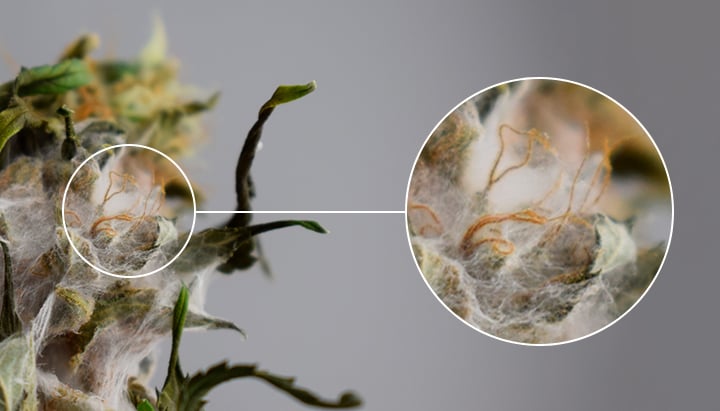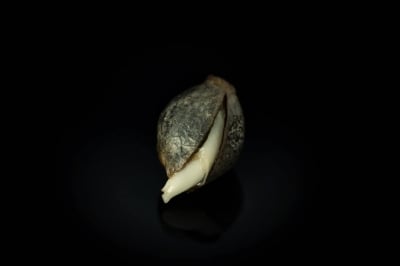.

Why You Should Use A Microscope During Cannabis Cultivation
Using a microscope when growing cannabis allows you to delve into the microscopic processes happening under your nose during the entire cultivation cycle. With the help of a little magnification, you'll suddenly find yourself able to scout pests, diagnose diseases, harvest your buds at the perfect time, and even assess the quality of your soil.
Contents:
Cannabis users are a diverse bunch. They have a range of different preferences and tastes when it comes to the strains they choose to smoke and grow. However, cannabis cultivators share more in common than you might think. For one, they all possess a near-identical tool kit when it comes to growing the plant they love, which includes containers, lights, key nutrients, and training equipment. Some take things a step further with digital hygrometers, pH testers, and brix metres. A handful of growers also use microscopes during the growing cycle.
It might sound odd, but more and more growers are dipping their toes into the realm of microscopy for the betterment of their weed plants. Why? Because it gives them a deeper understanding of the health of their crop, the ripeness of their buds, and even the status of their soil. Below, you’re going to find out why you should consider adding a microscope to your growing arsenal, and exactly what you can achieve by using one.


Why is it Important to Have a Microscope for Growing Cannabis?
Microscopes are used in a wide range of professions. Biological scientists use them to assess blood samples, geologists use them to identify rocks, and jewellers use them to observe the quality of potential purchases. But what function do microscopes have when it comes to growing good cannabis? In truth, weed microscopes have a host of functions that make them a compulsory piece of kit for an increasing number of keen cultivators.
Most commonly, cannabis growers will harness microscopes during the tail end of the flowering stage. At this time, they’re exceptionally helpful when it comes to harvesting at the correct time. By determining the maturity of buds by assessing the visual characteristics of anatomical components such as trichomes and pistils, growers are able to harvest a crop at the perfect time.
But microscopes have additional uses outside of harvest time. They help cultivators scout out and identify pests and diseases, allowing them to quickly develop and execute an integrated pest management solution to solve their biological problem.
Swathes of cannabis growers are also starting to realize the critical role that soil microbes play when cultivating weed. Using a microscope allows growers to take a peek into the rhizosphere and get an idea of the status of their soil—knowledge that results in increased fertility and plant health further down the line.
How Can Using a Microscope Improve the Quality and Potency of Cannabis Buds?
The human eye is a masterpiece of engineering, but it can only see so much. With limited magnification, most growers are taking lucky guesses when it comes to harvesting their crop at the right time—a decision that can greatly impact both the quality and potency of the subsequent yield.
Genetics and environmental factors are the two most important variables when it comes to THC content and aromatic terpene profiles. However, accurately timed harvesting helps to catch buds at the peak of their calibre. Using a microscope won’t miraculously enhance the quality of your flowers, but it’ll help you pinpoint the period where THC and terpene production are at their peak. Ultimately, you’ll make the effort of growing your own all the more worthwhile by using a cannabis microscope.
What are the Benefits of Using a Microscope?
You’re already aware of some of the key benefits of using a cannabis microscope. But the story goes much deeper! Below, we’re going to dive into more detail about the advantages of using magnification to grow magnificent marijuana.
You Can Take a Detailed Look at Trichomes
For the vast majority of cannabis cultivators, trichomes are the sole reason for growing the plant. Researchers refer to these small glandular structures as cellular metabolite factories[1]. There are several different types of trichomes that occur on cannabis flowers, but the stalked variety, which features a large globular head, produces most of the good stuff. These mushroom-shaped trichomes contain specialized enzymes and chemistry that enable them to constantly produce cannabinoids and terpenes, which they exude in the form of a sticky viscous resin.


But trichomes aren’t static structures. They drastically change in appearance throughout the flowering phase. In chronological order, they take on the following looks:
- Translucent: Younger trichomes are translucent in appearance. At this point, they are much lower in cannabinoids and terpenes, making them less potent and aromatic.
- Milky: As they mature, trichomes become milky and opaque. This indicates the increased production of cannabinoids, including THC, and aromatic terpenes. Concentrations peak when around 70% of observed trichomes take on this appearance.
- Amber: Eventually, plants mature to the degree that their chemical components start to degrade. For example, THC degrades into the more stoning cannabinoid CBN. This causes trichomes to take on an amber appearance.
Using a microscope around harvest time will allow you to pinpoint the ideal time to harvest your buds. For increased terpene and THC content, take them when trichomes are most cloudy. If you prefer the effect of CBN, wait for shades of amber to show up.
Supports Pest Management
Microscopes are a valuable tool as part of an integrated pest management strategy when it comes to prevention and treatment. They make for great scouting tools and can allow growers to identify eggs and small pest populations before they become a big deal. They also allow growers to identify the culprit once problems arise and tailor the appropriate response based on the pest in question. Magnification will allow the growers to observe key identifiable characteristics of flies, mites, gnats, and aphids.
Helps Diagnose Plant-Based Problems
Weed microscopes can help to diagnose more than relatively large insect pests. At high levels of magnification, they can also help spot diseases and help growers take the right course of action in response. Using a microscope allows cultivators to catch the likes of powdery mildew and bud rot in their early stages. They’re also helpful for analyzing root samples for signs of rot and the presence of plant-parasitic nematodes.


Assess Soil Health
Soil microbes play a vital role when growing cannabis. Just like us humans, each cannabis plant has a unique microbiome. When composted optimally, this community of microorganisms can help plants to thrive and reach their full potential. Healthy soil features a wealth of living organisms, and more diversity reduces the chances of diseases and enhances nutrient cycling down in the rhizosphere. Using a good microscope will give you a good idea of the concentration of bacteria, fungi, nematodes, protozoa, and arthropods within your soil.
Weed Under the Microscope: Visual Examples
Microscopes offer weed growers a bunch of advantages. But what exactly can you expect to see when you peer into an eyepiece for the first time? Keep scrolling to take a visit to the world of microscopic weed.
Trichomes Under the Microscope
Here, we have images of the three main types of trichomes found in cannabis flowers, at varying levels of maturity.
- Bulbous trichomes are spherical in shape and lack a stalk.
- Capitate-sessile trichomes possess a globular head on top of a short talk.
- Capitate-stalked trichomes feature a large head on a long stalk. These are the productive powerhouses that produce most of the terpenes and cannabinoids.
- Cystolithic trichomes are hair-like structures. They are non-glandular but possess important defensive functions.
Here, we have a much more detailed view of capitate-stalked trichomes under a scanning electron microscope. You can clearly make out the secretary disks, on the underside of the head, where cannabinoids and terpenes are released from.
Pistils Under The Microscope
Pistils, known by their correct botanical name of stigmas, are hair-like protrusions designed to catch airborne male pollen for fertilisation. Much like trichomes, their color reflects plant maturity and they serve as another visual cue for harvest timing.
Here, you can see what young and immature pistils look like. They are often brilliant white with a filled and fresh appearance.
Eventually, pistils become darker orange and brown and comparatively shrivelled. This indicates maturity and serves as a prompt to harvest.
Not all mature pistils turn brown or orange. Below, you can see red pistils—the result of high anthocyanin concentrations.


Pests Under the Microscope
Many pests are identifiable with the naked eye. However, the smaller the pest, the harder it is to get an accurate identification. Magnification will help you not only know what you're up against but will allow you to get a fascinating look into the anatomical details.
Here, you’re looking at aphids. These soft-bodied insects pierce cannabis tissue and extract the precious sap within. They’re often found on the underside of leaves. They’re usually green, yellow, or brown in appearance, and possess six legs.
These are aphid eggs. Knowing what they look like will help you to act early and prevent too much damage.
These are mealybugs. They’re sometimes confused with aphids. However, a microscopic view clearly distinguishes them based on their white fluffy appearance.
Hemp russet mites are the bane of many cannabis growers. You can identify them based on their tiny yellow-white bodies and maggot-like shape. Curled leaves are another surefire sign of their presence.
Check out these caterpillar eggs. You’ll sometimes come across them while pest scouting with a microscope. Catch them early, and you’ll prevent your plants from getting munched to pieces.
What Types of Microscopes Are Available?
You’re now aware of the many benefits of cannabis microscopes and their myriad uses. If you’re tempted to add one to your toolkit, it’ll help to get to know all of the different types available. Check out the options below to discover the right model for you.
Handheld Magnifying glass/jeweller’s loupe
Magnifying glasses and jeweller’s loupes are cheap but effective options for hobbyist growers. You won’t get a detailed look at soil life with these tools, but you’ll get a much better look at trichomes, pistils, and some pests.
Headband Magnifiers
These are essentially magnifying glasses that are strapped to the head. Again, they lack the superior magnification of microscopes. However, they allow for easy hand-free scouting and trichome/pistils analysis.
Handheld Digital Microscopes
These hand tools are cheaper than laboratory-grade microscopes. They’re small enough to carry on the go and can link up to a smartphone to remove the need to constantly stare down an eyepiece. Many models also come with a stand which makes them ideal for analyzing leaf samples. With magnification up to around 200×, you’ll get an in-depth look at pests, trichomes, and pistils.
Compound Light Microscope
These microscopes are the gold standard in soil science and plant diagnostics. They feature many moving parts, including stage controls, condensers, and coarse and fine focus adjusters, that allow users to get crystal-clear images of pests, diseases, and microbes. They're excellent for serious hobbyists and commercial growers when it comes to soil analysis. You’ll suddenly find yourself gazing at bacterial cells, fungi threads, and protozoa and nematodes. This will provide detailed information on the biological makeup of your soil.
Scanning Electron Microscopes
Scanning electron microscopes use electrons instead of light to generate an image. This technology creates an extremely detailed image of tiny objects using magnification of up to 500,000×. Because they’re extremely expensive, they’re restricted to high-end laboratories and are outside of the reach of hobbyist cannabis growers.
Which Microscope Works Best for Home Growing?
The type of microscopy you choose to use depends on your budget and how passionate you are about growing weed. Most cultivars will get by using a magnifying glass or handheld digital microscope. These devices will help you to harvest at the perfect time, and enable you to identify larger pests. Those with a bit more cash to splash, and more of an interest in soil biology, can grab a compound light microscope for several hundred pounds/euros. Once purchased, you’ll suddenly find yourself able to engineer your soil, diagnose diseases, and view plant cells in your own living room.
Get Up Close and Personal With Your Cannabis Plants
Nope—microscopes aren’t just for geologists and biological scientists! As you’ve seen, they make a handy addition to any cannabis growers toolkit. Much like other pieces of cultivation equipment, there are many different options available. Cheaper magnifying glasses and handheld digital microscopes will help you scout pests and identify the best time to terminate your grow. However, if you want to take things a step further, get yourself a compound light microscope to dive into the rhizosphere, perfect your soil, and diagnose diseases.
- Frontiers | Cannabis Glandular Trichomes: A Cellular Metabolite Factory https://www.frontiersin.org















































